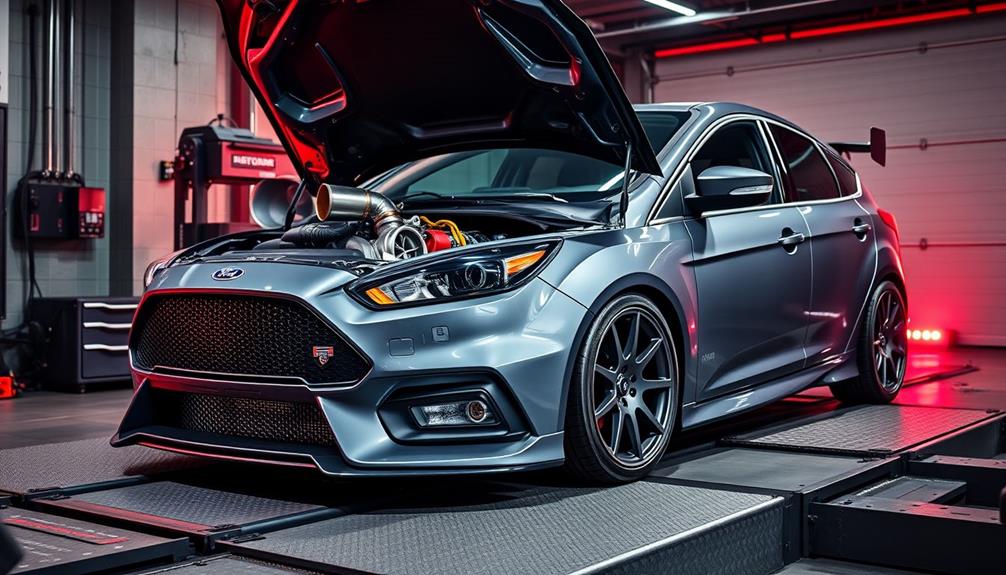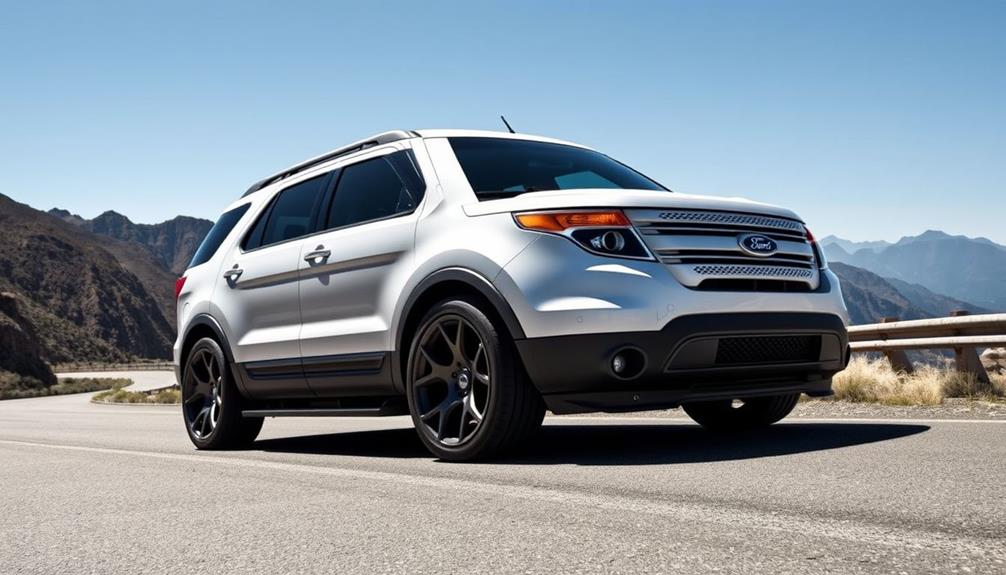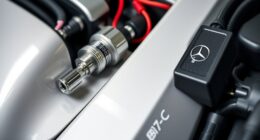Tuning your Ford Focus MK4 can dramatically enhance its power and performance. Start with ECU remapping to boost your engine's output to around 325 bhp. Pair this with a performance air intake system and exhaust upgrades for even more gains. Don't overlook suspension improvements; coilovers and sway bars will elevate handling and stability. Aesthetic upgrades like splitters and custom interiors can add personal flair while improving performance. Engaging with the Focus ST community can provide valuable tips and resources to guide your journey. Stick around, and you'll find even more ways to maximize your hatchback's potential. Additionally, many enthusiasts begin their journey with milder upgrades before diving deeper into the possibilities. With the Ford Focus 2012 hatchback tuning, you can apply similar principles, improving both everyday drivability and track capabilities. Whether you’re aiming for better lap times or just a more exhilarating daily drive, there are countless mods tailored specifically for this platform.
Key Takeaways
- ECU remapping can boost the Focus MK4's power output to around 325 bhp by optimizing engine parameters for performance.
- Upgrading to a performance air intake system can provide gains of up to 18 WHP and 31 Nm of torque.
- Installing a performance exhaust system reduces back pressure, enhancing both sound and overall power delivery.
- Intercooler upgrades are crucial for maintaining low intake air temperatures, preventing heat soak, and ensuring consistent performance.
- Combining various modifications can yield a total power increase of 30-40 HP, pushing the output to 310-320 HP.
Overview of the Ford Focus MK4
The Ford Focus MK4 stands out with its impressive 2.3L EcoBoost engine, delivering a thrilling 280 HP and 310 lb-ft of torque. This model, the final generation of the Focus ST before the shift to electric vehicles, promises an exhilarating driving experience.
With production ending in 2025, it's a hot commodity for enthusiasts.
The MK4 Focus ST features a more understated design than its predecessors while still packing advanced technology and high performance capabilities. Sharing many components with the previous Focus RS, this hatchback boasts improved reliability and significant tuning potential.
As you explore the aftermarket scene, you'll discover a robust array of performance upgrades available to elevate your driving experience. From ECU remaps to exhaust systems, these enhancements can provide substantial performance gains beyond the stock output.
This all-encompassing guide will help you navigate the options, allowing you to maximize the EcoBoost engine's capabilities.
Whether you're aiming to boost power output or simply enhance aesthetics, the Ford Focus ST MK4 is primed for customization, ensuring you can tailor it to your driving style.
Performance Engine Modifications

Maximizing your Ford Focus MK4's performance begins with a series of effective engine modifications.
Start with ECU remapping, a popular first step that can push your power output to around 325 bhp by optimizing engine parameters. This sets the foundation for further enhancements.
Upgrading to a performance air intake system is next; it improves airflow, giving you an average gain of +18 WHP and +31 Nm of torque, markedly boosting engine responsiveness.
Don't overlook a performance exhaust system either. It reduces back pressure, amplifying power while delivering an aggressive sound that complements your spirited driving.
To maintain consistent power during intense driving sessions, consider intercooler upgrades. These are essential for keeping intake air temperatures down, preventing heat soak and ensuring your engine performs at its best.
With these performance engine modifications, you can achieve power increases of 30-40 HP over stock output, bringing your Mk4 Focus ST to a thrilling 310-320 HP.
Suspension and Handling Upgrades

Upgrading your Ford Focus MK4's suspension can transform your driving experience, enhancing both comfort and performance. One of the best suspension upgrades you can make is installing coilovers, like the KW Coilover Kit V2, which allows for adjustable ride height and tailored handling characteristics.
If you're looking for a more budget-friendly option, consider lowering springs—they can effectively lower your vehicle's center of gravity, improving aerodynamics and stability.
To further enhance your ride, pair your coilovers or springs with performance shocks. These components provide increased ride comfort and control, making your driving experience more responsive.
Sway bars are also essential; they reduce body roll during cornering, giving you better grip and stability, especially during track-focused driving.
Don't overlook strut braces, either. Installing them increases chassis rigidity, greatly improving your steering response and overall handling dynamics.
With these suspension upgrades, your Focus MK4 will feel more connected to the road, allowing you to enjoy a thrilling driving experience while maximizing performance. Each modification you make contributes to a well-rounded setup, ensuring your hatchback performs at its best.
Aesthetic and Interior Enhancements

When you want to elevate your Ford Focus MK4's style, aesthetic and interior enhancements play an important role.
These upgrades not only improve visual appeal but also enhance your overall driving experience. A well-planned budget for modifications can help guarantee you maximize your investment in both style and performance, making it vital to set savings goals for these upgrades.
Here are three impactful modifications to take into account:
- Aesthetic Upgrades: Bolt-on modifications like splitters, spoiler extensions, and vinyl wraps give your Focus an aggressive stance that turns heads on the road.
- Lowering Springs: These budget-friendly options lower your car's center of gravity, improving aerodynamics and enhancing performance without major alterations.
- Interior Customization: Upgrading to aftermarket shift knobs and pedals allows you to personalize your cabin, creating a unique atmosphere that reflects your style.
Whether you're aiming for a street-ready ride or a unique show car, these modifications help you stand out.
Trust reputable brands for wheels and tires to guarantee safety and performance while maintaining that sleek look.
With the right aesthetic enhancements, your Ford Focus MK4 won't only perform better but also become a true expression of your individuality.
Community and Learning Resources

Enhancing your Ford Focus MK4's aesthetic appeal is just the beginning of your tuning journey. Engaging with the Focus ST community can greatly boost your experience. You'll find valuable resources and support among fellow DIY enthusiasts keen to share their tuning experiences and modifications. Document your process on platforms like Instagram or YouTube to inspire others while connecting with a network of modifiers.
Participating in automotive events and local car meets provides hands-on learning opportunities. You'll meet other enthusiasts, exchange ideas, and discover hidden power in your tuning efforts. Here's a quick overview of key community resources:
| Resource Type | Examples | Benefits |
|---|---|---|
| Online Forums | Focus ST Forums | Advice and troubleshooting |
| Social Media Groups | Facebook/Twitter Communities | Networking and inspiration |
| Automotive Magazines | Performance Car Magazines | Trends and part recommendations |
| YouTube Channels | Tuning and DIY Channels | Visual installation guides |
| Local Events | Meet-ups and Track Days | Hands-on experience |
Utilizing these resources guarantees you're well-equipped to maximize your Focus MK4's performance pack and enhance its power delivery.
Frequently Asked Questions
How Much HP Can a Ford Focus ST Handle?
Your Ford Focus ST can typically handle a safe increase of 30-40 HP beyond its stock 280 HP. With proper tuning, you could push it to around 325 HP while maintaining reliability and performance.
Is the Ford Focus Easy to Mod?
Oh, sure, the Ford Focus is a real challenge to mod! You'll find it's actually quite simple. With the right parts and community support, you'll be boosting performance before you know it. Enjoy the ride!
Are Ford Focus Hatchbacks Fast?
Yes, Ford Focus hatchbacks are fast. With their turbocharged engines, they deliver impressive acceleration and competitive top speeds. You'll enjoy the thrilling driving experience, especially when you push them to their performance limits.
What Is the Drag Coefficient of the Ford Focus Mk4?
With a drag coefficient of approximately 0.30, the Ford Focus MK4 excels in aerodynamic efficiency. This low Cd not only enhances your fuel economy but also improves your driving experience at higher speeds.
Conclusion
In your quest for a thrilling Ford Focus MK4, remember that every enhancement enhances your experience. From powerful performance tweaks to stunning suspension upgrades, you can transform your hatchback into a head-turning powerhouse. Don't forget the dazzling details that elevate your interior, making every ride a joy. Immerse yourself in the dynamic community of fellow enthusiasts, where shared strategies and spirited support spark your journey. With passion and persistence, you'll create a Focus that's both fierce and fabulous!










